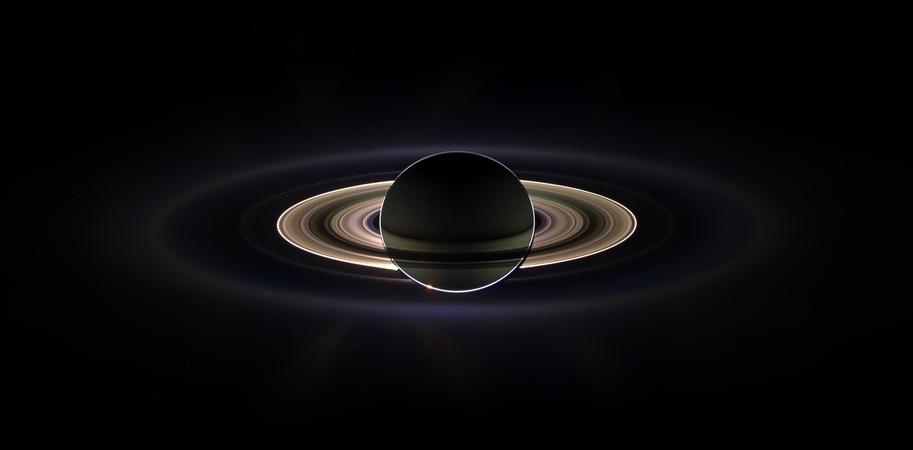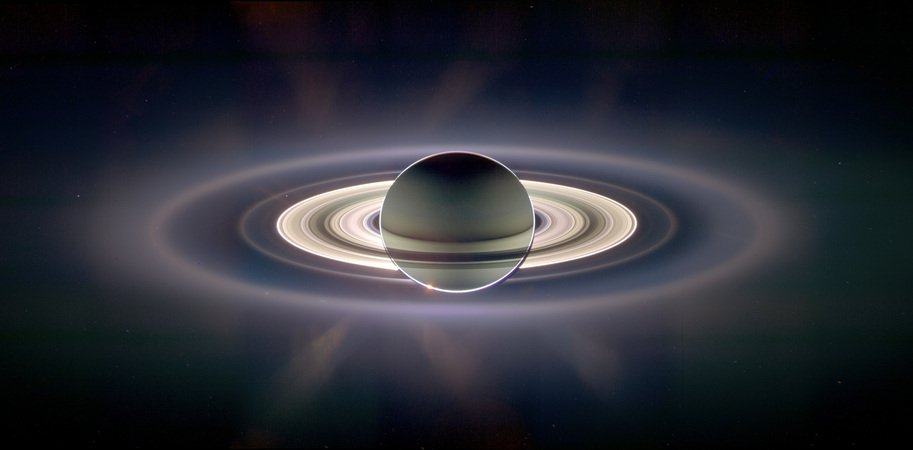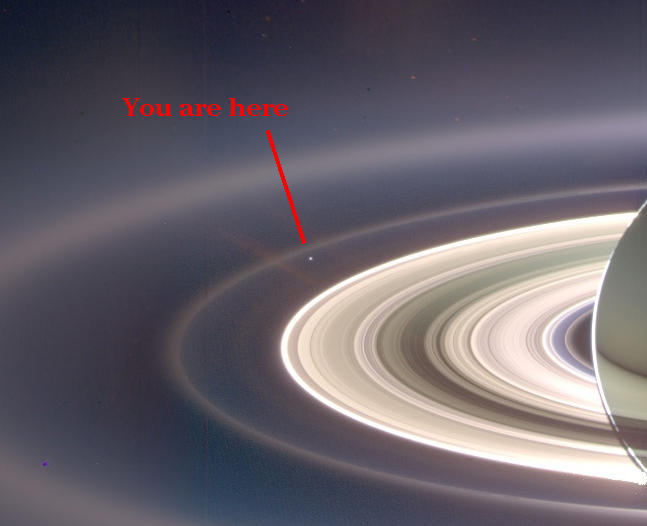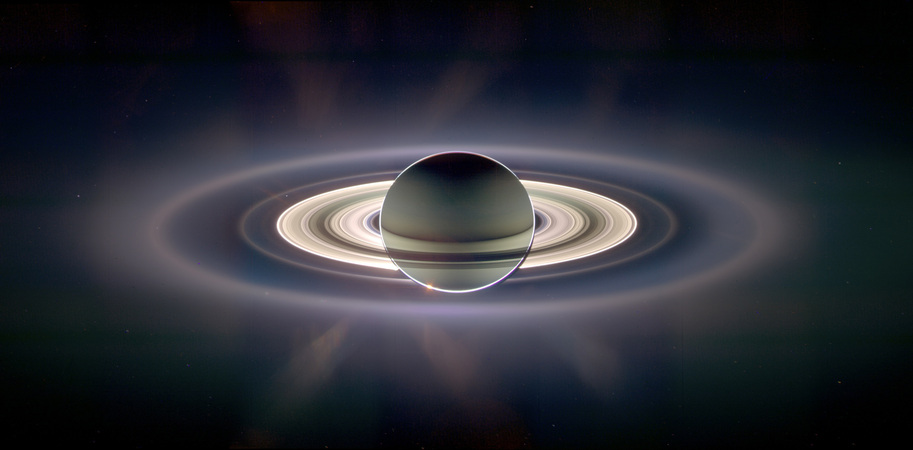- Fri 25 May 2007
- Astronomy
- #Astronomy, #Images
 The image is an excerpt from one of the most spectacular Saturn images
I have seen. It was snapped by the
Cassini-Huygens
mission to Saturn on 15 Sep 2006.
The image is an excerpt from one of the most spectacular Saturn images
I have seen. It was snapped by the
Cassini-Huygens
mission to Saturn on 15 Sep 2006.
The image is an enhanced composite of
images taken over a twelve hour period as the spacecraft passed through
the shadow of the planet. The Sun is backlighting the planet, throwing
the rings into a new light and providing scientists an opportunity to
study them in new ways.
 The
unenhanced image can be seen to the right (click for larger version). In
this image we can clearly see ring (annulus) of light around the
planet's edge caused by sunlight being refracted (bent) through the
outermost atmospheric layers toward the camera. The ring system,
Saturn's most distinctive feature, is brightly lit and clearly visible
beyond the extent of the planet. Where the rings pass in front of the
planet they appear dark, obscuring the weak illumination of the planet's
dark side by light reflected from the rings. The broad, dark band in the
rings is visible from Earth in modest amateur telescopes and is called
the Cassini Division after its discoverer Giovanni
Cassini.
The Cassini division was thought to be a vacant gap between the A
(outer) and B (inner) rings. Just inward from the very bright edge of
the ring system (F ring, discovered 1979) is the Encke Gap named for
Johann
Encke.
Near the planet's lower left edge is a bright spike that hints at
another ring, and below the planet is a faint blue streak that one could
be forgiven for thinking was some kind of lens flare.
The
unenhanced image can be seen to the right (click for larger version). In
this image we can clearly see ring (annulus) of light around the
planet's edge caused by sunlight being refracted (bent) through the
outermost atmospheric layers toward the camera. The ring system,
Saturn's most distinctive feature, is brightly lit and clearly visible
beyond the extent of the planet. Where the rings pass in front of the
planet they appear dark, obscuring the weak illumination of the planet's
dark side by light reflected from the rings. The broad, dark band in the
rings is visible from Earth in modest amateur telescopes and is called
the Cassini Division after its discoverer Giovanni
Cassini.
The Cassini division was thought to be a vacant gap between the A
(outer) and B (inner) rings. Just inward from the very bright edge of
the ring system (F ring, discovered 1979) is the Encke Gap named for
Johann
Encke.
Near the planet's lower left edge is a bright spike that hints at
another ring, and below the planet is a faint blue streak that one could
be forgiven for thinking was some kind of lens flare.
 The
image truly comes alive when the brightness levels are adjusted (left).
The Cassini Division no longer looks like an abrupt break in the rings
as more, faint, rings appear in the 'gap'; their locations dictated by
orbital
resonance
with Saturnian moons. The bright spike has resolved into a ring (G ring)
discovered by the Voyager
mission in
1980-1. The pale blue streak is fully illuminated, betraying its nature
as a full ring (the E ring, discovered 1966). The character of the
reflected light tells us that E ring differs from the majority of the
rings; it consists of diffuse microscopic particles rather than larger
lumps of ice and rock. The source of this material is thought to be
volcanism on the Saturnian moon
Enceladus
which orbits within the haze. New rings, not easily visible in this
scaled image were discovered by Cassini scientists in this image data
("Janus/Epimetheus" Ring between F and G, and "Pallene" Ring betwee G
and E).
The
image truly comes alive when the brightness levels are adjusted (left).
The Cassini Division no longer looks like an abrupt break in the rings
as more, faint, rings appear in the 'gap'; their locations dictated by
orbital
resonance
with Saturnian moons. The bright spike has resolved into a ring (G ring)
discovered by the Voyager
mission in
1980-1. The pale blue streak is fully illuminated, betraying its nature
as a full ring (the E ring, discovered 1966). The character of the
reflected light tells us that E ring differs from the majority of the
rings; it consists of diffuse microscopic particles rather than larger
lumps of ice and rock. The source of this material is thought to be
volcanism on the Saturnian moon
Enceladus
which orbits within the haze. New rings, not easily visible in this
scaled image were discovered by Cassini scientists in this image data
("Janus/Epimetheus" Ring between F and G, and "Pallene" Ring betwee G
and E).
Spectacular as the image of Saturn is, the thing that really tugs on my
sense of wonder is an almost insignificant dot called the Earth that
makes an appearance just inside the G ring in the centre-right. At the
time this image was taken Cassini-Huygens was about 2.2 million
kilometres from Saturn and 1.5 billion kilometres from Earth. A similar
image, in which the Moon can be seen as a bump on the side of Earth is
here.

Read more about the Saturn ring system at Wikipedia.
Image Credit: NASA/JPL/Space Science Institute
PIA08329: In Saturn's
Shadow
PIA08324: Pale Blue
Orb
Clear skies!
